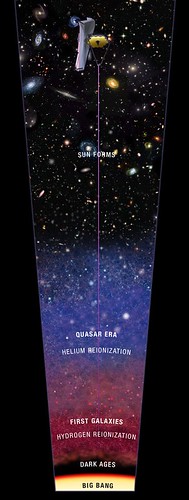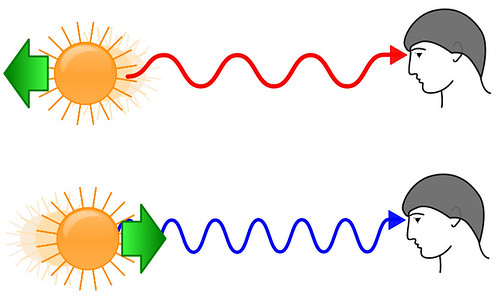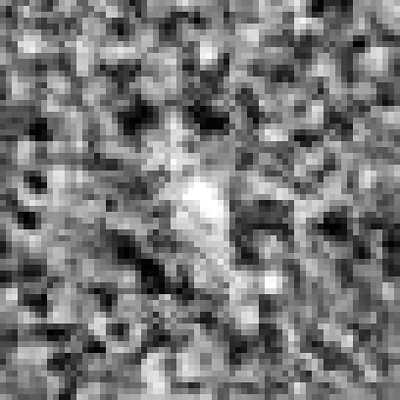Why infrared? (earliest galaxies edition)
- By Maggie Masetti
- September 12, 2013
- Comments Off on Why infrared? (earliest galaxies edition)
This is the second blog in a series which asks the question, why infrared? Last time we looked at how infrared light could reveal baby stars hidden from visible-light observatories by opaque clouds of gas.
In this blog I’m going to talk about (what else?) the James Webb Space Telescope and why a powerful infrared observatory is key to seeing the first stars and galaxies that formed in the universe. Why would we want to see the first stars and galaxies that formed? Well, the fact is, we haven’t yet! The microwave COBE and WMAP satellites saw the heat signature left by the Big Bang about 380,000 years after it occurred. But at that point there were no stars and galaxies.
After the Big Bang, the universe was like a hot soup of particles (i.e. protons, neutrons, and electrons). When the universe started cooling, the protons and neutrons began combining into ionized atoms of hydrogen (and eventually some helium). These ionized atoms of hydrogen and helium attracted electrons, turning them into neutral atoms – which allowed light to travel freely for the first time, since this light was no longer scattering off free electrons. The universe was no longer opaque! However, it would still be some time (perhaps up to a few hundred million years post-Big Bang!) before the first sources of light would start to form, ending the cosmic dark ages. Exactly what the universe’s first light (ie. stars that fused the existing hydrogen atoms into more helium) looked like, and exactly when these first stars formed is not known. These are some of the questions JWST was designed to help us to answer.

Credit: STScI
The James Webb Space Telescope will be able to see back to about 100 to 250 million years after the Big Bang. But why do we need infrared light to see what was going on in the early universe?
Imagine light leaving the first stars and galaxies nearly 13.6 billion years ago and traveling through space and time to reach our telescopes. We’re essentially seeing these objects as they were when the light first left them 13.6 billion years ago. By the time this light reaches us, its color or wavelength has been shifted towards the red, something we call a “redshift.” Why? In this particular case, it’s because when we talk about very distant objects, Einstein’s General Relativity comes into play. It tells us that the expansion of the universe means it is the space between objects that actually stretches, causing objects (galaxies) to move away from each other. Furthermore, any light in that space will also stretch, shifting that light’s wavelength to longer wavelengths. This can make distant objects very dim (or invisible) at visible wavelengths of light, because that light reaches us as infrared light.

Credit: Uncyclopedia
For very high redshifts (ie, the farthest objects from us), that visible light is generally shifted into the near- and mid-infrared part of the electromagnetic spectrum. For that reason, to see the first stars and galaxies, we need a powerful near- and mid-infrared telescope, which is exactly what JWST is!

Credit: NASA
At the time of my recent blog Farthest, the candidate for record holder for farthest observed object ever was an object from the Hubble UDF12 survey. The redshift of the light observed from this galaxy (with a value of 11.9) tells us that the light was emitted about 380 million years after the Big Bang. This means the light from this galaxy (pictured below) left 13.3+ billion light years ago.

Credit: NASA, ESA, R. Ellis (Caltech), and the UDF 2012 Team
The Farthest blog also goes through a few other other ultra distant objects. In many of these instances, astronomers used the incredibly strong gravity of massive galaxy clusters to magnify the light from them so observatories like NASA’s Hubble Space Telescope and the European Southern Observatory’s Very Large Telescope could see them.
If the first galaxies started forming 200 million years after the Big Bang (as predicted by the theoretical model of galaxy evolution), JWST will be able to see them without even the aid of gravitational lensing. (So in effect, JWST will be testing this prediction about galaxy evolution!) Gravitational lensing could allow JWST to see these objects better, but it won’t necessarily let us see further back in time before the first stars and galaxies. (And that is again because there wasn’t anything there to see!)

The James Webb Space Telescope, Credit: Northrop Grumman
So there we have it – baby stars AND the first bright objects that formed in the universe! Is there anything else infrared light can reveal to us? Tune in to a future blog to see! Until then, please enjoy this fantastic cartoon developed by the Space Telescope Science Institute about infrared light:


